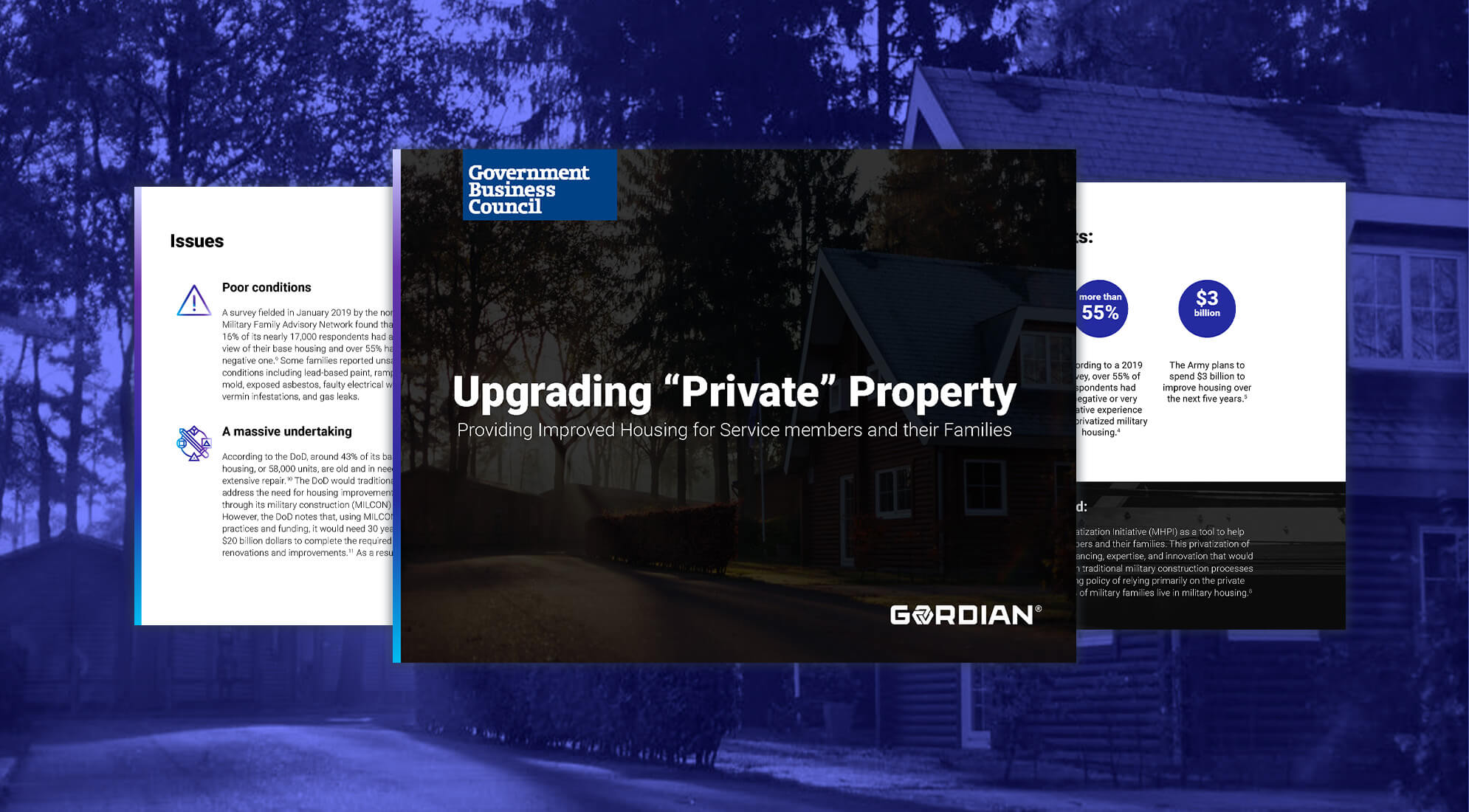Each year, the Society of American Military Engineers (SAME) hosts their Joint Engineer Training Conference, at which representatives from military branches meet to report on current initiatives, problem-solve for challenges and discuss innovative solutions. As part of the conference, leaders from the Department of Defense (DOD), Department of Homeland Security (DHS), Veterans Affairs (VA) and State Department share their investment priorities for the near future.
At this year’s Training Conference, branch leaders placed a particular focus on the renovation and modernization of domestic properties. Many military facilities are built for a 50-year lifecycle, meaning they are meant to be replaced or significantly renovated within that window. However, it’s common for continental United States (CONUS) military infrastructure and facilities to exceed that benchmark, resulting in degraded conditions. One study found that 29% of DOD facilities have exceeded their intended lifecycles by at least 10 years.
It’s common for continental United States (CONUS) military infrastructure and facilities to exceed that benchmark, resulting in degraded conditions. One study found that 29% of DOD facilities have exceeded their intended lifecycles by at least 10 years.
Thankfully, branch leaders at this year’s Training Conference indicated that military construction (MILCON) budgets for sustainment, renovation and modernization (SRM) have increased across all branches, signaling that the current administration recognizes a need to invest in outdated military facilities. That said, the backlog of needs is enormous, and inflationary forces may constrict the number of projects that can be completed.
Considering that the MILCON investment priorities listed below are multi-year – or multi-decade, in some cases – initiatives, it’s unlikely that any of them will be knocked off course by current market conditions. But there’s potential for them to be slowed. If that’s the case, then the current backlog of outdated facilities and infrastructure could compound even further.
Here is a high-level look at the domestic SRM priorities.
DOD’s MILCON Investment Priorities
Army and USACE
Many sectors of the private market are exploring electrification and decarbonization efforts, but it will take federal groups leading the charge to create a large-scale shift away from fossil fuel reliance. To that end, the Army is planning to transition its domestic vehicle fleet entirely to electric-powered vehicles over the next five years.
The vehicles themselves will comprise a significant expense, but the greater cost will come with ensuring that grid capacities can accommodate the increase in electricity consumption. The Army Corps of Engineers (USACE) will head the testing and, where necessary, overhaul of the power grid. They’ll require the help of design and contracting groups along the way, presenting opportunities across the nation for contractor work.
USACE has signaled that a key priority in their electrification initiative will be project readiness, ensuring that individual projects are delivered on time to keep the entire process moving forward. Any contractors looking to be involved in the Army’s electrification efforts should be prepared to prove their readiness track record.
Navy
The Navy is beginning a multi-billion-dollar shipyard modernization program, which is greatly needed. Like other military structures, these shipyards are intended to be maintained according to a 50-year lifecycle. Letting shipyards and wharfs extend beyond that mark without sufficient renovations creates a national security issue. But the average age of a Navy operated wharf is between 70 and 75 years old, nearly 50% beyond lifecycle.
Simultaneous to their shipyard program, the Navy is looking to construct new naval bases on several Pacific islands. The shipyard program and Pacific islands program alike present considerable challenges in budgeting, both because of the sheer size of the programs and their dispersed locations.
Producing accurate estimates for building them will be difficult and require specialized, contextual data that can account for market condition fluctuations and elongated travel for materials and equipment, particularly for remote island locations. Data like this is time intensive to create, but it can be done.
DHS’s MILCON Investment Priorities
Coast Guard
The Coast Guard’s upcoming investment priorities meet somewhere between the Army’s and Navy’s, albeit on a smaller scale. The Guard plans to replace their entire fleet of ships in the near future and increase the size of their fleet in the process. But before they can, they need to update their shipyards to accommodate the new fleet. Some of their shipyards are so antiquated that they were built to service wooden ships, having gone without updates while the Guard has slowly battled a $1 billion backlog of infrastructure needs.
As part of the updates to their shipyards, the Coast Guard will invest in improved hurricane resiliency for their facilities. As sea levels change and climates continue to grow warmer, high category hurricanes have become an increased threat to Guard bases. Damage from strong storms has added to the mounting backlog of needs, and storm-proofing facilities will address the current backlog while helping reduce future backlog growth.
MILCON Opportunities Abound, But So Does Competition
With MILCON budgets increasing, it would be reasonable to expect a greater volume of contracts to be awarded and more projects to be completed over the next year. But two forces are pulling those trends downward. As mentioned before, inflation is reducing the real value of increased budgets. Even if long-term MILCON investment priorities remain top of mind for branches in the next half decade, the coming fiscal year won’t see a boom of projects.
Additionally, industry experts are reporting a consolidation of government contract awards. According to GovExec at their 2022 GAIN Conference presentation, 2021 witnessed a 53% increase in competition for government contracts. Yet, there was a 14% decrease in the number of companies awarded those contracts. That adds up to more competitors for contracts but fewer winners, as contracts are increasingly being awarded to larger companies whose names have long been familiar to agency leaders.
2021 witnessed a 53% increase in competition for government contracts. Yet, there was a 14% decrease in the number of companies awarded those contracts. That adds up to more competitors for contracts but fewer winners.
With a more competitive landscape, contractors should look into innovative ways to secure federal work, such as long-term contracts, like SATOCs, MATOCs, SABERs and JOCs. While these contract methods won’t be used for large, new construction projects, they give contractors access to a steady line of government SRM projects over a span of years without having to compete for each project. Because of this, these contract vehicles also enable federal agencies and branches to reduce administrative costs and expedite project timelines.
With over 30 years as the leader in Job Order Contract development and management, Gordian is the ideal industry partner for contractors or agencies looking to implement a JOC program. Having developed a comprehensive set of JOC best practices, Gordian can help you realize the proven benefits of JOC. For more information on JOC, click the Contact Us button in the top right corner of the screen.









